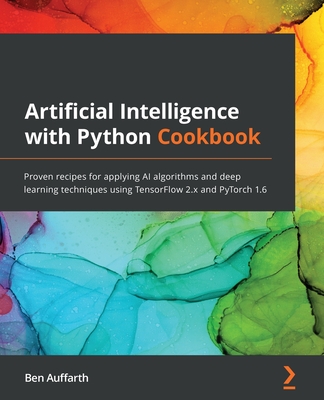The Deep Learning Architect's Handbook: Build and deploy production-ready DL solutions leveraging the latest Python techniques
暫譯: 深度學習架構師手冊:利用最新的 Python 技術構建和部署生產就緒的深度學習解決方案
Chin, Ee Kin
- 出版商: Packt Publishing
- 出版日期: 2023-12-29
- 售價: $2,130
- 貴賓價: 9.5 折 $2,024
- 語言: 英文
- 頁數: 516
- 裝訂: Quality Paper - also called trade paper
- ISBN: 1803243791
- ISBN-13: 9781803243795
-
相關分類:
Python、程式語言、DeepLearning
海外代購書籍(需單獨結帳)
商品描述
Harness the power of deep learning to drive productivity and efficiency using this practical guide covering techniques and best practices for the entire deep learning life cycle
Key Features:
- Interpret your models' decision-making process, ensuring transparency and trust in your AI-powered solutions
- Gain hands-on experience in every step of the deep learning life cycle
- Explore case studies and solutions for deploying DL models while addressing scalability, data drift, and ethical considerations
- Purchase of the print or Kindle book includes a free PDF eBook
Book Description:
Deep learning enables previously unattainable feats in automation, but extracting real-world business value from it is a daunting task. This book will teach you how to build complex deep learning models and gain intuition for structuring your data to accomplish your deep learning objectives.
This deep learning book explores every aspect of the deep learning life cycle, from planning and data preparation to model deployment and governance, using real-world scenarios that will take you through creating, deploying, and managing advanced solutions. You'll also learn how to work with image, audio, text, and video data using deep learning architectures, as well as optimize and evaluate your deep learning models objectively to address issues such as bias, fairness, adversarial attacks, and model transparency.
As you progress, you'll harness the power of AI platforms to streamline the deep learning life cycle and leverage Python libraries and frameworks such as PyTorch, ONNX, Catalyst, MLFlow, Captum, Nvidia Triton, Prometheus, and Grafana to execute efficient deep learning architectures, optimize model performance, and streamline the deployment processes. You'll also discover the transformative potential of large language models (LLMs) for a wide array of applications.
By the end of this book, you'll have mastered deep learning techniques to unlock its full potential for your endeavors.
What You Will Learn:
- Use neural architecture search (NAS) to automate the design of artificial neural networks (ANNs)
- Implement recurrent neural networks (RNNs), convolutional neural networks (CNNs), BERT, transformers, and more to build your model
- Deal with multi-modal data drift in a production environment
- Evaluate the quality and bias of your models
- Explore techniques to protect your model from adversarial attacks
- Get to grips with deploying a model with DataRobot AutoML
Who this book is for:
This book is for deep learning practitioners, data scientists, and machine learning developers who want to explore deep learning architectures to solve complex business problems. Professionals in the broader deep learning and AI space will also benefit from the insights provided, applicable across a variety of business use cases. Working knowledge of Python programming and a basic understanding of deep learning techniques is needed to get started with this book.
商品描述(中文翻譯)
利用這本實用指南,駕馭深度學習的力量,以提升生產力和效率,涵蓋整個深度學習生命週期的技術和最佳實踐
主要特點:
- 解釋模型的決策過程,確保您在 AI 驅動解決方案中的透明度和信任
- 在深度學習生命週期的每一步獲得實踐經驗
- 探索案例研究和解決方案,以部署深度學習模型,同時解決可擴展性、數據漂移和倫理考量
- 購買印刷版或 Kindle 書籍可獲得免費 PDF 電子書
書籍描述:
深度學習使得自動化達成以前無法實現的成就,但從中提取現實世界的商業價值是一項艱鉅的任務。本書將教您如何構建複雜的深度學習模型,並獲得結構化數據以實現深度學習目標的直覺。
這本深度學習書籍探討了深度學習生命週期的每個方面,從規劃和數據準備到模型部署和治理,使用現實世界的場景,帶您創建、部署和管理先進解決方案。您還將學習如何使用深度學習架構處理圖像、音頻、文本和視頻數據,以及如何客觀地優化和評估您的深度學習模型,以解決偏見、公平性、對抗攻擊和模型透明度等問題。
隨著進展,您將利用 AI 平台的力量來簡化深度學習生命週期,並利用 Python 庫和框架,如 PyTorch、ONNX、Catalyst、MLFlow、Captum、Nvidia Triton、Prometheus 和 Grafana,執行高效的深度學習架構,優化模型性能,並簡化部署過程。您還將發現大型語言模型(LLMs)在各種應用中的變革潛力。
在本書結束時,您將掌握深度學習技術,充分發揮其在您工作中的潛力。
您將學到什麼:
- 使用神經架構搜索(NAS)自動設計人工神經網絡(ANNs)
- 實現循環神經網絡(RNNs)、卷積神經網絡(CNNs)、BERT、變壓器等來構建您的模型
- 在生產環境中處理多模態數據漂移
- 評估模型的質量和偏見
- 探索保護模型免受對抗攻擊的技術
- 掌握使用 DataRobot AutoML 部署模型
本書適合誰:
本書適合希望探索深度學習架構以解決複雜商業問題的深度學習從業者、數據科學家和機器學習開發者。更廣泛的深度學習和 AI 領域的專業人士也將從中獲益,這些見解適用於各種商業用例。開始閱讀本書需要具備 Python 編程的工作知識和基本的深度學習技術理解。






























